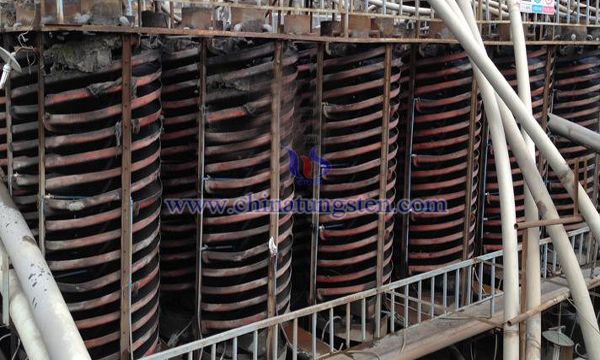Tungsten from Sulfide Tailings Recycle
- Details
- Category: Tungsten Information
- Published on Monday, 04 March 2019 22:38
Tungsten deposits are the traditional superior mineral resources in China. There are many kinds of tungsten deposits in China. The causes of mineralization are complex and the forms of mineralization are diverse. With the large-scale development and utilization of tungsten resources and the continuous improvement of beneficiation and metallurgical technology, high-quality primary tungsten resources are consumed in large quantities, the boundary grade of tungsten mining is decreasing day by day, and many associated tungsten resources are reused by people.

How to recover tungsten from sulfide ore? Finding a suitable beneficiation method is the key. The original ore is copper bismuth tungsten ore, which contains 1.13wt% copper, 0.36wt% bismuth, 0.04wt% tungsten and 4.64wt% sulphur.
(1)The object of this process is: the copper bismuth ore with low-grade tungsten is treated by sulfide flotation process. The separation yield is 4.74wt%, the copper grade and recycle are 20.36% and 85.49% respectively, and the yield is 2.35wt%, the bismuth grade and recycle are 8.53% and 55.67% respectively. The tailings obtained are the feed of this process.
(2)Step (1) Water is added to the ore to adjust the slurry concentration to 25 wt%, and then the slurry is fed into the spiral chute system for preliminary classification.
(3)The coarse sand products of spiral chute obtained in step (2) are fed into the high frequency vibrating screen system for grading. The screening size of the high frequency vibrating screen is 104 micron (150 meshes).
(4)The fine sand products of spiral chute obtained in step (2) are fed into the hydrocyclone system for classification. The classification standard of the hydrocyclone is 37 micron, and the overflow products of the hydrocyclone are classified into tailings.
(5)The products on the high frequency vibrating screen obtained in step (3) are fed into the shaking bed separation system, and the concentrates separated by the shaking bed system are classified into tungsten concentrates, while the other products are classified into tailings.
(6)merge the products of the cyclone screening products obtained with step (3) and the hydrocyclone sediment products obtained by step (4) to the desulphurization flotation operation. The foam products for desulphurization flotation are pyrite concentrate, the yield of sulphur concentrate is 10.63wt%, the grade and recycle rate of sulfur are 28.56% and 65.45% respectively.
(7)the underflow products obtained from step 6 will be selected for flotation of tungsten flotation. Tungsten foam flotation products are classified into tungsten concentrate, and the bottom products of tungsten flotation are classified into tailings.
(8)The final yield, tungsten grade and recycle of tungsten concentrate are 1.21wt%, 1.87% and 56.65% respectively. The products classified into tailings in steps (4), 5 and 7 are merged into final tailings. The tungsten grade of the final tungsten concentrate is more than 1%, and the tungsten recycle rate is more than 55%.
Comments: The process flow is reasonable and the processing capacity is large. It is especially suitable for process adaptation in large sulfide concentrator. The process has wide adaptability to raw materials and is easy to be industrialized.
- Tungsten Manufacturer & Supplier, Chinatungsten Online: www.chinatungsten.com
- Tungsten News & Prices of China Tungsten Industry Association: www.ctia.com.cn
- Molybdenum News & Price: news.molybdenum.com.cn
- Tel.: 86 592 5129696; Fax: 86 592 5129797; Email: sales@chinatungsten.com



 sales@chinatungsten.com
sales@chinatungsten.com